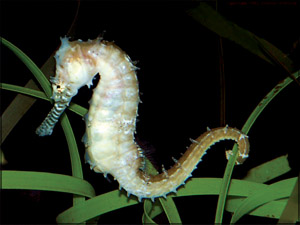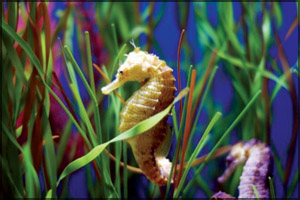Fascinating seahorses
by Ruwini Jayawardana
While
those of us like to own pets like dogs, cats, birds and fish, there are
a few of us who prefer to have an uncommon pet such as a kola, mongoose or a snake. Seahorses too are a
good choice for people of such tastes but require a lot of care and
time. Let us have a brief idea on them to see if this pet will meet up
with your tastes.
uncommon pet such as a kola, mongoose or a snake. Seahorses too are a
good choice for people of such tastes but require a lot of care and
time. Let us have a brief idea on them to see if this pet will meet up
with your tastes.
Seahorses are classified as fish, but they are very different from
other fish because they have no scales, lack teeth, and do not have a
stomach. There are 35 known species of seahorse around the world.
Seahorses can grow as large as 22 centimeters but are more commonly
between 10 and 15 centimeters in length. Seahorses usually live in
underwater seagrass meadows and among reefs.
They eat small crustaceans, worms and other invertebrates. Seahorses
are masters of camouflage and can quickly change colour to avoid being
eaten by larger fish and birds. Their eyes move independently - so one
eye
 can
look in one direction and the other eye can look at something else! can
look in one direction and the other eye can look at something else!
Perhaps the most fascinating thing about seahorses is how they
reproduce - the male becomes pregnant! When seahorses mate, the female
lays her eggs in the male's abdominal brood pouch. The male fertilises
them and nurtures them by himself for up to six weeks when the baby
seahorses are born.
Seahorses propel themselves by different means. The main thrust comes
from their dorsal fin that beats 70 times a minute. Pectoral fins on
side of the face are used to steer a course.
are used to steer a course.
Seahorses also have a prehensile tail that wraps around objects so
they can rest or hide themselves amidst protective plants.
Unfortunately, around the world seahorses are rapidly moving toward
becoming an endangered species. There is a huge trade in seahorses and
their underwater habitats are threatened by pollution.
Despite their attraction as aquarium fish, seahorses are difficult to
maintain in an artificial environment. Conditions have to be perfect and
they also require a constant supply of food. They require very
specialised care, and are not a pet to be taken lightly. |
